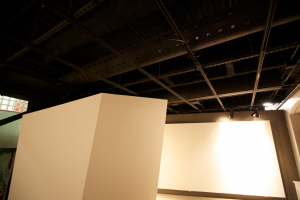
Laying the Foundations – Understanding CEREV’s Technology Needs
This is the first of what I am hoping to be a continuing blog presence presenting an overview of my thought processes, discoveries and technical challenges in designing, implementing, and facilitating a digital exhibition workshop for CEREV. I feel lucky to be involved with Concordia’s innovative facilities, and would like to thank Dr. Erica Lehrer, whose vision of employing interactive media to expand the opportunities for engaging with human narrative and experience has made this all possible.
In my initial interview with Dr. Lehrer and tour of the CEREV facilities, I realized that given the scope of the project, the design process would be iterative. In order to maximize the potential of the project itself careful research, planning and testing of software/ hardware solutions had to be done. Like anything in life, each solution opens many new questions and these questions eventually provide the framework for how to move forward.
So with this first blog post, let me share some of my initial questions as I embark as the media facilitator for the CEREV project.
1. Who are the key users for the technology? I immediately thought of the “KSA” model, used to identify knowledge, skills and attitude of the key players – in this case graduate students and university faculty. My past experiences conducting workshops with professors and graduate students have demonstrated a wide range of ability and comfort in working with technology. As a premise, I often look for three key factors when choosing software or hardware: Simplicity, Usability and Functionality.
2. What is the project mandate? The idea behind CEREV is to provide alternative media to augment and communicate the research of graduate students and faculty by providing a venue and resources for media training, collaboration, and exhibition experimentation.
3. What are the facilities and how are they to be used? CEREV is comprised of three spaces: two are actual physical spaces, and a third, more conceptual one.
• The first space, the Workshop, is a small-scale “gallery” intended for curatorial experimentation. It is a design studio and ‘show’ room to create and debate faculty/student research with what will be a networked audio/video system for multiple projections, installations and interactive presentational media. It will allow for the development of experimental modes of exhibition and display, and for exhibition ideas to be generated and critiqued before they are show publicly.
• The second space is the Incubator, a cozy collaborative media room. This room serves as a group brainstorming and media processing station, where digital audio and video can be planned, screened, edited and debated. It is a collective idea space that offers collaborative technologies to facilitate the seeds of group curatorial projects that will move at a later stage of development downstairs into the Workshop.
• The third space is more conceptual. CEREV would also like to engage a larger community outside the University by designing community exhibitions that engage the public to consider or interact with media the faculty and students create.
These questions (and their answers) provide the context of what CEREV is, and they provide the framework that will guide my decision-making around the Centre’s technology and training. Further, they lay the groundwork for my ongoing media musings in future blog posts, as I share my experiences, resources and suggestions. Any comments are appreciated, if you have any ideas please share them!I’m not sure I want to name this third conceptual space here, as it seems to speak to a different issue, and one we haven’t yet worked out. Perhaps instead you can say the third space is the CEREV website, which will be linked to “cloud spaces” supported by GoDaddy, where individual and group projects-in-development can be archived, viewed, and discussed by colleagues and invited guests.



